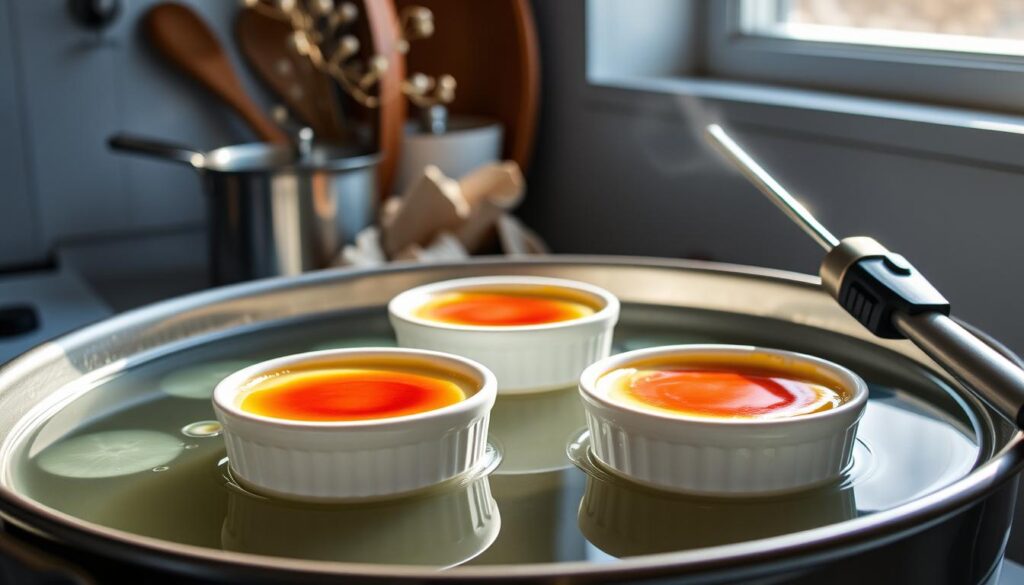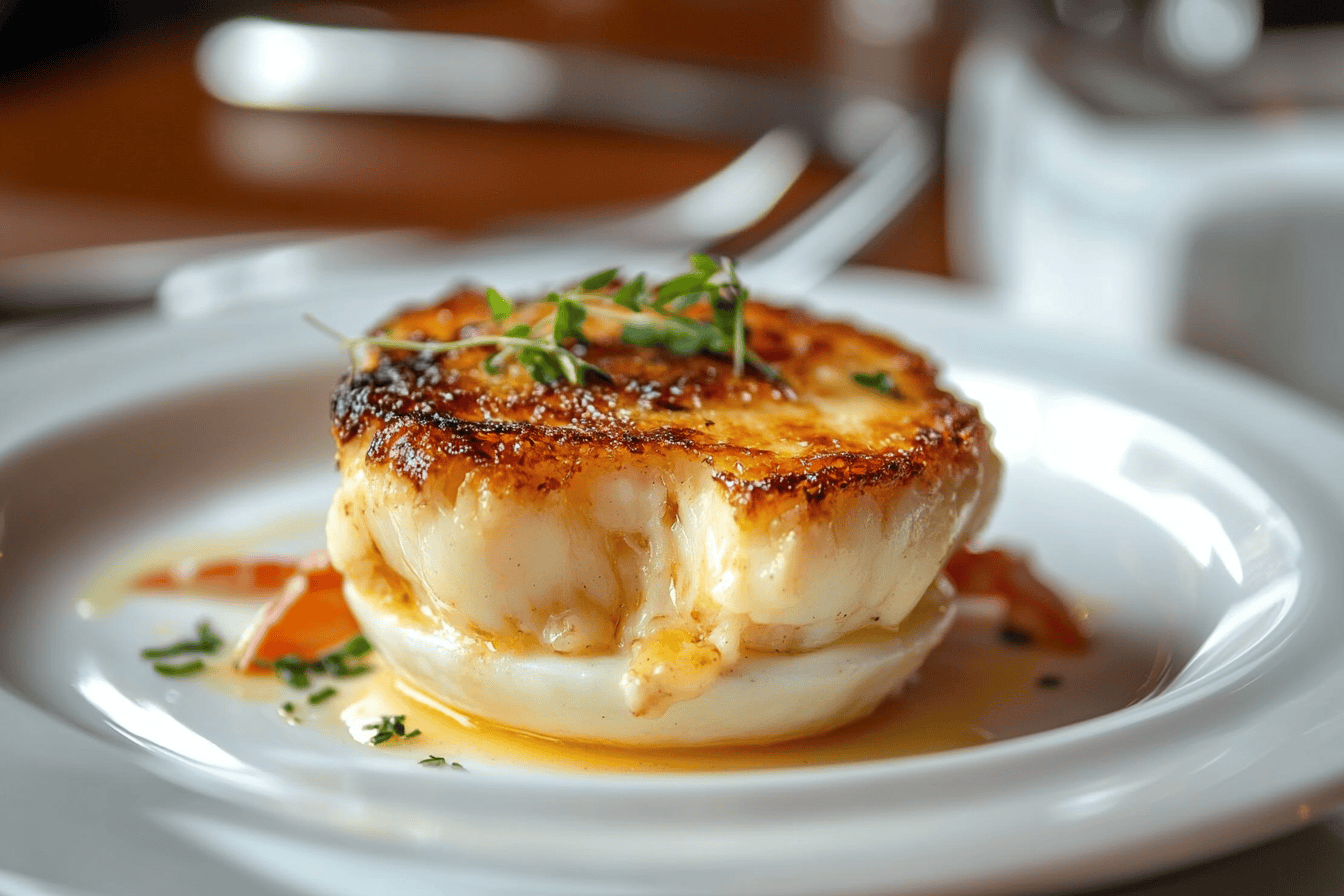Why is Crème Brûlée Cooked in a Water Bath, If you’ve ever tried crème brûlée, you might wonder why it’s cooked in a water bath. Is it just tradition, or does the water bath really matter for the custard’s texture? Let’s explore the secrets behind this method and why it’s vital for making perfect crème brûlée.
Key Takeaways
- The water bath method helps control the temperature and promote even heat distribution for a silky-smooth custard.
- Cooking crème brûlée in a water bath prevents curdling and ensures the desired creamy texture.
- The water bath maintains the proper moisture balance during baking, preventing the custard from becoming dry or overcooked.
- Understanding the science behind the water bath technique is key to mastering the art of crème brûlée preparation.
- Proper water bath set-up and temperature monitoring are crucial for consistently successful crème brûlée results.
Understanding the Classic French Dessert: Crème Brûlée Basics
Crème brûlée is a French dessert loved by many. It has a creamy custard base and a caramelized top. This dessert has a rich history and a mix of traditional ingredients that make it special.
Origins and Cultural Significance
The history of crème brûlée starts in the late 17th century. French chefs created custard-based desserts back then. The name “burnt cream” comes from the caramelized sugar on top.
Over time, crème brûlée became a big part of French dessert culture. It shows France’s love for making fancy and rich sweets.
Traditional Ingredients and Components
The basic ingredients for crème brûlée are cream, egg yolks, sugar, and vanilla. The custard is made by heating the cream and mixing it with egg yolks. This makes the custard smooth and creamy.
To get the caramelized sugar on top, sugar is sprinkled over the custard. Then, a kitchen torch is used to melt and caramelize it.
The Science Behind Perfect Custard
Getting the custard right is all about science. The mix of cream, egg yolks, and sugar creates a smooth texture. The way it’s heated and cooled helps it set perfectly.
The custard is baked in a water bath. This keeps the temperature steady and prevents the custard from curdling or getting bubbles.
“Crème brûlée is a triumph of simplicity – a few high-quality ingredients, carefully combined and prepared, result in a dessert that is both elegant and indulgent.”
The Essential Role of Water Bath in Crème Brûlée Preparation
Creating the perfect crème brûlée requires a water bath, or bain-marie. This method is key for the dessert’s silky texture and custard-like consistency.
The water bath’s gentle heat is crucial for baking the custard. It cooks the custard evenly, avoiding overcooking. This method keeps the custard moist and prevents it from becoming too firm.
The water bath technique is vital for crème brûlée’s custard. It cooks the custard slowly, making it silky and velvety. This is what makes the classic French dessert so creamy and firm.
| Benefits of Water Bath Cooking | Drawbacks of Direct Baking |
|---|---|
| Gentle, even heat distribution Prevents curdling and texture issues Maintains moisture balance during baking | Uneven heating leading to overcooking Risk of curdling and grainy texture Potential for drying out and losing moisture |
Both professional chefs and home cooks use the water bath for perfect crème brûlée. It ensures the custard’s velvety texture and rich consistency. This makes it a must for this beloved French dessert.

Why is Crème Brûlée Cooked in a Water Bath
Crème brûlée, a French dessert, is cooked in a water bath, or bain-marie. This method is key for its perfect texture. It ensures the custard is silky and creamy.
Temperature Control and Even Heat Distribution
The water bath keeps the temperature steady during baking. It surrounds the ramekins with hot water. This way, the dessert cooks evenly, avoiding hot spots.
This control is vital for custard temperature control. It prevents the custard from becoming too hot or curdling.
Preventing Curdling and Texture Issues
Crème brûlée is a delicate custard. The water bath method prevents it from curdling. It keeps the temperature low, avoiding grainy or rubbery textures.
Moisture Balance During Baking
The water bath also helps with moisture balance. It creates a humid environment around the ramekins. This prevents the custard from drying out or forming a skin.
This moisture preservation is key for the rich, velvety texture of the final crème brûlée.
Equipment Needed for Water Bath Cooking
For the perfect crème brûlée, you need the right tools, especially for a water bath. You’ll need crème brûlée ramekins and baking dishes for the water bath. The right kitchen tools make a big difference in getting a smooth custard.
Crème Brûlée Ramekins
The crème brûlée ramekin is key. They come in sizes from 4 to 8 ounces. Choose ceramic or porcelain ramekins for even heat and to avoid curdling.
Baking Dishes for Water Bath
You’ll also need a bigger baking dish for the water bath. This could be a roasting pan or a casserole dish. It should be deep enough to cover the ramekins halfway.
| Kitchen Tool | Purpose | Recommended Features |
|---|---|---|
| Crème Brûlée Ramekins | Holds the custard | Ceramic or porcelain, 4-8 oz capacity |
| Baking Dish for Water Bath | Holds the water bath | Deep enough to submerge ramekins halfway |
| Kitchen Torch | Caramelizes the sugar topping | Adjustable flame for even caramelization |
| Oven-Safe Trivet | Supports ramekins in water bath | Heat-resistant, prevents direct contact with water |
A kitchen torch and an oven-safe trivet are also useful. The torch gives you a caramelized sugar topping. The trivet keeps the ramekins stable in the water bath.
With the right equipment, your crème brûlée will always be perfect. You’ll get a smooth custard and a crispy caramel top.
Common Mistakes to Avoid When Using a Water Bath
Mastering crème brûlée needs careful attention, especially with the water bath method. Stay away from these common mistakes to get perfect custard every time.
Water Temperature Guidelines
Keeping the water at the right temperature is key for a smooth crème brûlée. The water should be between 325°F and 350°F (165°C and 175°C). If the temperature changes, your custard might cook unevenly, becoming too runny or curdled.
Proper Ramekin Placement
It’s important to place ramekins right in the water bath for even heating. Make sure they’re not touching the sides of the dish. This lets the water move around each dessert, cooking them evenly.
Avoiding Water Spillage
One big water bath mistake is water getting into the ramekins. Pour the water carefully to avoid splashing. You can also use foil or parchment paper to keep water out.
| Common Crème Brûlée Troubleshooting Issues | Solutions |
|---|---|
| Uneven cooking | Maintain water temperature between 325°F and 350°F (165°C and 175°C) |
| Curdled custard | Ensure proper ramekin placement and avoid water spillage |
| Soggy or watery texture | Carefully monitor water level and baking time |
By avoiding these baking tips and common mistakes, you’ll make perfect crème brûlée every time.
Differences Between Water Bath and Direct Baking Methods
Preparing crème brûlée can be done in two main ways: water bath or direct baking. Knowing the differences between these methods helps you choose the best one. This choice affects the creamy texture and caramelized top of your dessert.
The water bath method, or bain-marie, involves placing ramekins in a pan of hot water. This method cooks the custard gently and evenly. It prevents curdling or cracking. On the other hand, direct baking puts ramekins straight in the oven. This method uses intense heat.
| Water Bath Method | Direct Baking Method |
|---|---|
| Gentle, even heat distribution | Intense, direct heat |
| Prevents curdling and cracking | Higher risk of curdling and cracking |
| Longer baking time | Shorter baking time |
| Moist, creamy texture | Drier, more dense texture |
The direct baking method is quicker but the water bath is preferred for crème brûlée. The water bath’s gentle heat makes the custard silkier and more consistent. It also reduces the risk of uneven cooking, curdling, and cracking.
Choosing between water bath and direct baking depends on your preference and desired texture. Both methods can yield great results. However, the water bath is often more reliable for perfecting crème brûlée.
Professional Tips for Perfect Water Bath Technique
Mastering the water bath technique is key for perfect crème brûlée. As a professional baking enthusiast, I’m here to share valuable tips. These will help you make this classic French dessert every time.
Proper Water Level
The right water level is crucial for a successful water bath. The water should reach halfway up the sides of your ramekins. This ensures even heat and prevents waterlogging of the custard. Pour the water into the baking dish carefully, avoiding splashes into the ramekins.
Temperature Monitoring
Temperature control is vital for perfect custard. Use an oven-safe thermometer to monitor the water bath temperature. Keep it between 325°F and 350°F for gentle, even cooking. This results in a silky-smooth texture.
Timing Considerations
Timing is everything with crème brûlée. Custard may take 30 to 45 minutes to set, depending on ramekin size. Keep an eye on the clock and avoid opening the oven door. This can disrupt cooking and cause uneven results.
By following these tips, you’ll make crème brûlée with creamy, rich custard. Your guests will love it. Embrace the art of this classic French dessert and show off your baking skills.
Achieving the Perfect Custard Consistency
Making the perfect custard is key to a great crème brûlée. It’s all about the right mix of ingredients and cooking skills. To get that silky-smooth custard, follow these tips.
The egg-to-cream ratio is very important. More eggs mean a richer custard. Less eggs make it thinner. Find what you like by trying different ratios.
Also, how and when you cook it matters a lot. Bake at 300°F for a slow, even cook. Too hot can ruin the texture, so be careful.
| Ingredient | Ideal Ratio |
|---|---|
| Eggs | 6-8 large egg yolks |
| Heavy Cream | 2 cups |
| Sugar | 1/2 cup |
By using these tips and trying different things, you’ll make a fantastic custard. This is the base of a top-notch crème brûlée.
“The texture of the custard is the key to a great crème brûlée. It should be velvety smooth, with a rich, creamy mouthfeel.”
Troubleshooting Common Water Bath Issues
Making the perfect crème brûlée is a delicate task. The water bath method is key to getting the custard just right. But, even experienced bakers can face problems. Let’s look at some common issues and how to fix them.
Overcooked Custard
If your custard is too firm and dry, the water bath might have been too hot. Or, it could have baked for too long. To avoid this, watch the water bath’s temperature closely. Adjust the oven as needed. Also, check the custard often and take it out when it’s just set.
Undercooked Centers
If the centers are still loose, the water bath might have been too cold. Or, it baked for too short a time. Make sure the water bath is at the right temperature before adding the ramekins. You might need to bake it a bit longer to get it right.
Texture Inconsistencies
Uneven heating can cause texture problems. Make sure the water level is right, covering the ramekins but not overflowing. Also, place the ramekins to allow for even heat, avoiding any blockages.
| Common Water Bath Issues | Possible Causes | Troubleshooting Solutions |
|---|---|---|
| Overcooked Custard | – Water bath temperature too high – Baking time too long | – Monitor water bath temperature closely – Adjust oven temperature as needed – Remove from oven as soon as centers are just set |
| Undercooked Centers | – Water bath temperature too low – Baking time too short | – Ensure proper water bath preheating temperature – Extend baking time in small increments |
| Texture Inconsistencies | – Uneven heating in water bath – Improper ramekin placement | – Maintain proper water level in bath – Arrange ramekins to allow for optimal heat circulation |
By tackling these common problems, you can become a pro at making crème brûlée. You’ll get that silky custard and caramelized top that make it so loved.
Alternative Methods and Modern Approaches
While the traditional water bath method is still the best for crème brûlée, new techniques are catching on. The sous vide method and steam ovens are becoming popular. They offer unique benefits.
Sous Vide Technique
The sous vide method cooks custard in water baths at precise temperatures. It’s loved by chefs and home cooks. This method makes the crème brûlée silky and creamy.
It also keeps the flavors locked in. This is hard to do with traditional baking.
Steam Oven Options
Steam ovens are another way to make crème brûlée. They keep the custard moist and prevent cracks. The heat is even, making the texture perfect.
Both sous vide and steam ovens have their challenges. They need practice to get right. But, they can make your crème brûlée truly special.
Conclusion
Throughout this article, you’ve learned the importance of using a water bath for perfect crème brûlée. This classic French dessert is known for its creamy custard and caramelized top. By understanding the science behind it, you can make restaurant-quality crème brûlée at home.
The water bath method ensures even heat and prevents curdling. It keeps the custard moist and smooth. With the right tools and care, you can impress your guests with your cooking skills.
Whether you stick to traditional baking or try sous vide, the tips here will help you make perfect crème brûlée. Follow these suggestions to take your homemade desserts to the next level. Soon, your crème brûlée will be a signature dish in your kitchen.
FAQ
What is crème brûlée made of?
Crème brûlée is a French dessert. It has a custard base of cream, egg yolks, and sugar. On top, a layer of caramelized sugar adds a sweet crunch.
What’s the difference between crème brûlée and custard?
Crème brûlée has caramelized sugar on top. Custard is smooth and creamy, made from eggs, milk, and sugar. Crème brûlée adds a caramelized sugar layer on top.
How do you make crème brûlée with a blowtorch?
First, make the custard base. Bake and chill it. Then, sprinkle sugar on top and caramelize it with a blowtorch.
Why is crème brûlée cooked in a water bath?
Cooking in a water bath keeps the custard smooth. It prevents overcooking and curdling. This method ensures a creamy texture.
What is the difference between water bath and direct baking methods for crème brûlée?
The water bath method is best for crème brûlée. It uses a pan of hot water to cook the custard. This method prevents uneven cooking and keeps the custard smooth. Direct baking can lead to curdling and a grainy texture.

